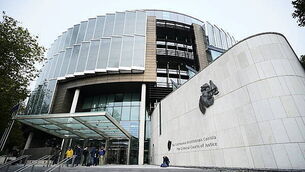Fatal collision between Luas and pedestrian 'unavoidable', inquest hears

Seán McCárthaigh
An inquest into a fatal incident between a Luas tram and a pedestrian lying on the track near the Green Line terminus at Broombridge three years ago heard evidence that the collision was “unavoidable”.
A sitting of Dublin District Coroner’s Court also heard that Luas operator, Transdev, had implemented a number of changes as a result of the fatal collision, including the imposition of a 25km/h speed limit on any area where individuals are reported to be trespassing on the railway line.
Patrick Green (51), a homeless man who was classified as a missing person at the time of his death, was killed instantly in the collision with the Luas tram, which occurred at 1.14am on September 18th, 2022.
The inquest heard the deceased, who had to be identified through DNA profiling due to the extent of his injuries, had been escorted off a different tram about 40 minutes earlier after he was found asleep in a carriage at the terminus at Broombridge.
CCTV footage showed that Mr Green, who had been lying on the track just before the fatal incident, had his left leg severed when the Luas tram passed over him about 275 metres from the Broombridge stop.
The location of the fatal collision was in an area with no public lighting, while the deceased was wearing dark clothing.
A forensic collision investigator, Garda Lyn Connaughton, gave evidence that the incident occurred on a section of track with a 70km/h speed limit.
She told the inquest that her investigation showed that the tram was travelling at a speed of 44km/h at the point of impact.
It took another ten seconds before the tram was brought to a halt about 67 metres from the scene of the collision.
The inquest heard that tram drivers had visibility of 38 metres of the track ahead with full beam lights at the location.
Garda Connaughton said tests to calculate stopping distances with the tram showed it would take 41-47 metres for a driver to halt a tram at the speed being driven at the time of the collision when allowing for a reaction time.
Incident was 'unavoidable'
She claimed in such circumstances that the fatal incident was “unavoidable”.
A former Luas driver who was operating the last tram that night, Samson Osas, gave evidence that he had reduced his speed after having been alerted about a trespasser on the track between Broombridge and Cabra.
Mr Osas said two security staff, who were directly behind him in the first carriage, were also keeping a lookout for some movement on the line ahead.
Mr Osas said he suddenly felt a boom underneath the tram and heard its “bodycatcher” being deployed.
“I didn’t see anyone or anything in front of me,” he recalled.
Mr Osas said he originally thought the tram had struck an animal as he believed he would have seen a person on the track.
In reply to questions from the coroner, Clare Keane, he said the issue of trespassers on Luas tracks was “something that happens every day.”
Mr Osas said he had put the tram’s full lights on, which would be unusual in normal circumstances, after being alerted about a trespasser, as visibility on that section of track was poor.
Another tram driver, Vincent Byrne, told the hearing that he had driven the third last tram that night, which had arrived at Broombridge at 00.35am.
Mr Byrne said he came across a male slumped in one of the carriages as he was walking through the tram to check for “sleepers.”
He gave evidence that he radioed for assistance from security staff after he tried a number of times unsuccessfully to wake the passenger.
Mr Byrne said he was informed by a Luas controller that security guards were on the last tram and were 10-15 minutes away, but that gardaí could be called, if necessary.
However, he said he decided to try and wake the passenger again as the man was not causing any trouble.
Mr Byrne said he managed to wake up the male, from whom there was a strong smell of alcohol
The inquest heard that the deceased, when asked if he had had a good night, replied that he had “too much to drink”.
Mr Byrne said the passenger had also commented: “You have a great attitude. Keep up the good work.”
He told the coroner that Mr Green was “no trouble and very placid.”
Mr Byrne said he escorted the passenger, who was unsteady on his feet, to sit him on a wall at the Broombridge stop.
However, he said he saw the man near the track a short time later as he was moving the empty tram into the nearby depot.
The driver said he alerted his control centre, who warned other tram drivers to proceed with caution as there was a trespasser on the line near Broombridge.
An inspector with the Health and Safety Authority, Frank Kerins, said the deceased had been in an unauthorised area of the Luas track and that appropriate warning signage was in place.
No criminal prosecution
The inquest heard that the DPP had directed that no criminal prosecution should arise from the circumstances of Mr Green’s death.
Transdev’s director of operations, David Rooney, said a speed restriction of 25km/h had been introduced on any section of track where a trespasser had been reported following Mr Green’s death.
Mr Rooney said the speed restriction could not be lifted until security staff had also carried out a “sweep” of the area.
He told the hearing that Transdev was satisfied that signage alerting the public about the danger of trespassing on Luas tracks in the area at the time was sufficient.
In reply to questions from a jury foreperson, Mr Rooney observed that it would be possibly more dangerous to move intoxicated people further away than escorting them to Luas stops.
He pointed out that stops were considered a safe place to leave such individuals as they were well lit, had seats, shelter and CCTV cameras, while there was a speed limit of 10km/h for trams at platforms.
A postmortem revealed that the deceased had died as a result of multiple traumatic injuries.
Tests also showed the level of alcohol in his system was over six times the legal drink-driving limit, while the presence of benzodiazepines was also detected.
Dr Keane noted that medical records showed that Mr Green, who was a frequent visitor to the Mater Misericordiae University Hospital, had suffered from chronic alcoholism and was concerned about seizures, although he did not suffer from any acute illness.
A jury of nine women and two men returned a verdict of death by misadventure.
They also recommended that Transdev should carry out some media advertising about trespassing on Luas lines.
Offering condolences to Mr Green’s family, including his sister, Daphne, who attended the hearing, Dr Keane said his death was “deeply tragic”.









